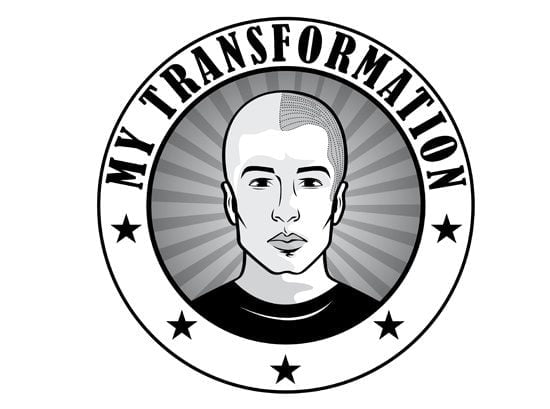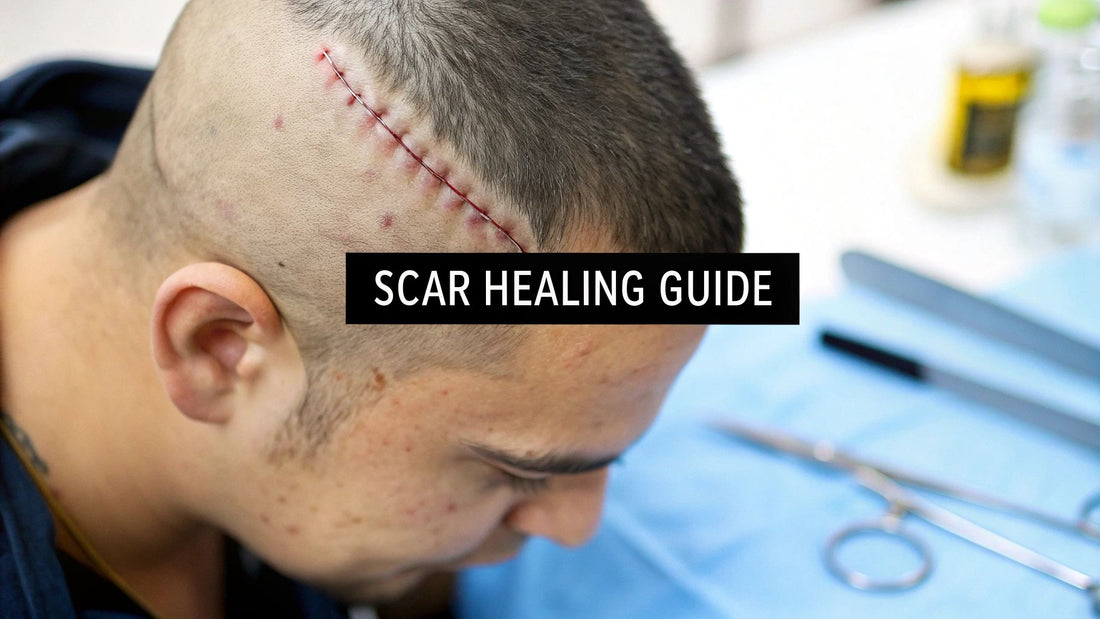
Hair Transplant Scars What You Really Need to Know
Share
Let's get one thing straight: any hair transplant, no matter how advanced, will leave a scar. It's an unavoidable part of the process. However, the good news is that modern techniques have made these scars incredibly difficult to spot.
A Follicular Unit Transplantation (FUT) procedure will leave a fine, linear scar in the donor area. In contrast, a Follicular Unit Extraction (FUE) procedure results in tiny, dot-like scars. The real difference is that FUE scarring is scattered and often completely unnoticeable, even if you like to keep your hair quite short.
Understanding the Reality of Hair Transplant Scars
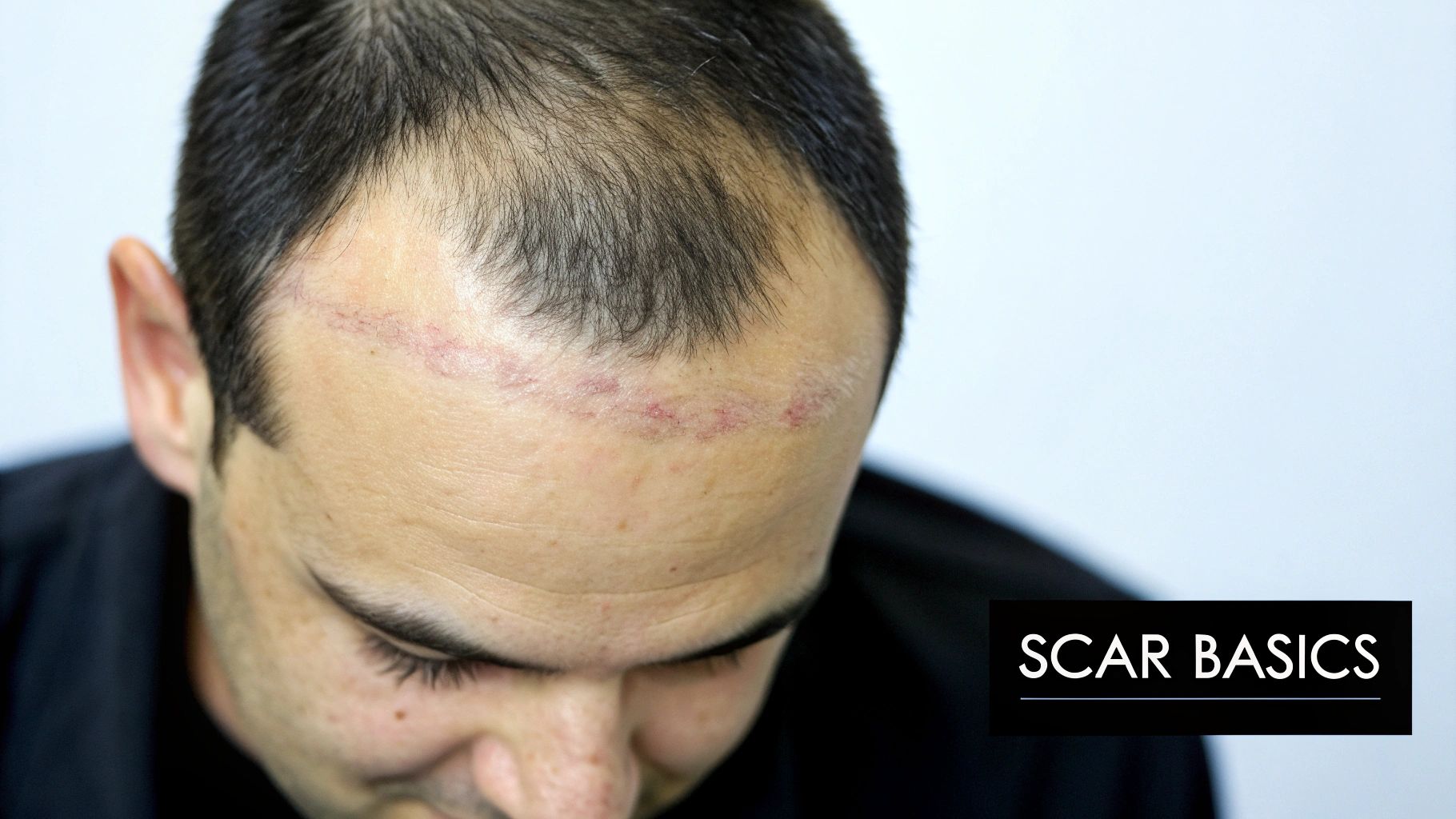
One of the biggest myths out there is that you can get a hair transplant without any scarring at all. The reality is that any surgical procedure that involves cutting or extracting tissue from the skin is going to leave a mark as the body heals itself.
Think of your scalp as a smooth piece of fabric. A hair transplant involves making thousands of tiny alterations to that fabric. Even with the most delicate, precise instruments, a small mark is always left behind.
The goal of a great hair restoration surgeon isn't to somehow avoid scarring completely—that's just not possible. The true art lies in making the scars so minimal and strategically placed that they become practically invisible to the naked eye. This comes down to a combination of surgical precision and excellent post-operative care.
The Two Main Types of Hair Transplant Scars
To really get your head around scarring, you need to understand the two main hair transplant methods. Each one leaves a very different kind of scar, so your choice of procedure will directly impact the type of mark left in your donor area (usually the back and sides of your head).
-
Follicular Unit Transplantation (FUT) Scar: This is the 'strip' method. The surgeon removes a thin strip of hair-bearing scalp from the donor area and then carefully stitches the incision closed. This leaves a single, very fine linear scar that’s easily hidden by the surrounding hair. Think of it like a tailor neatly sewing a seam.
-
Follicular Unit Extraction (FUE) Scar: With FUE, there's no strip. Instead, individual hair follicles are extracted one by one using a tiny, circular punch tool. This leaves behind hundreds or thousands of small, dot-like scars scattered across the donor area. It’s more like making tiny pinpricks in the fabric—the individual marks are minuscule, and they blend right into the background.
The question isn't if you'll have a scar, but what kind of scar it will be. FUT concentrates the scarring into one line, while FUE spreads it out as tiny, faded dots.
Why Setting Realistic Expectations Matters
Knowing from the outset that a scar is part of the deal helps you make a much more informed decision. While a top-tier surgeon can minimise scarring to a point where it's almost undetectable, any clinic promising a "scarless" procedure isn't being entirely upfront.
How visible your scar will be depends on a few key things: the surgeon's skill, your body's natural healing ability, and how closely you follow the aftercare instructions. By understanding this from the beginning, you can go into your hair restoration journey with clear, realistic expectations and feel confident about the amazing results to come.
Comparing Scarring from FUT and FUE Procedures
When it comes to hair transplant scars, the single biggest factor in what you’ll end up with is the surgical method you choose. The two main techniques, Follicular Unit Transplantation (FUT) and Follicular Unit Extraction (FUE), leave behind very different types of scarring simply because of how the donor hair is collected.
Getting your head around these differences is the key to matching the procedure with your lifestyle and how you like to wear your hair—especially if you're a fan of a very short cut.
The FUT Strip Method and Its Linear Scar
Follicular Unit Transplantation, which most people know as the "strip method," is exactly what it sounds like. The surgeon removes a thin, narrow strip of scalp from the donor area, usually from the back of your head where the hair is densest. This approach is incredibly efficient, allowing the team to harvest a huge number of grafts in one go.
Once the strip is removed, the incision is carefully closed up with sutures. The unavoidable result is a single, fine linear scar. How this scar ultimately looks comes down to a few critical things:
- Surgeon's Skill: A top-tier surgeon will use advanced techniques like trichophytic closure, which cleverly encourages hair to grow through the scar tissue, making it much harder to spot.
- Scalp Laxity: The natural flexibility of your scalp plays a part. A tighter scalp can sometimes lead to the scar healing slightly wider.
- Aftercare: Following your post-op instructions to the letter is crucial for a clean, flat, and minimal scar.
In the hands of an expert, an FUT scar can be remarkably subtle, often just 1-2 mm wide. It’s easily hidden by the surrounding hair, as long as you don't buzz it right down.
The FUE Punch Method and Its Dot Scars
Follicular Unit Extraction (FUE) flips the script entirely. Instead of taking a strip, the FUE technique involves harvesting individual follicular units one by one, directly from the scalp. This is done using a tiny circular punch tool, typically less than 1.0 mm in diameter.
Because there’s no long incision, you avoid a linear scar completely. What you get instead are hundreds, sometimes thousands, of tiny, dot-like scars scattered across the donor area. It’s less like a line and more like a subtle stippling pattern.
The real beauty of FUE scarring is how spread out it is. Because these tiny marks aren't all in one place, they blend in with the surrounding hair follicles and become incredibly difficult to notice.
This makes FUE the go-to choice for men who want the freedom to wear their hair very short without worrying about a tell-tale scar.
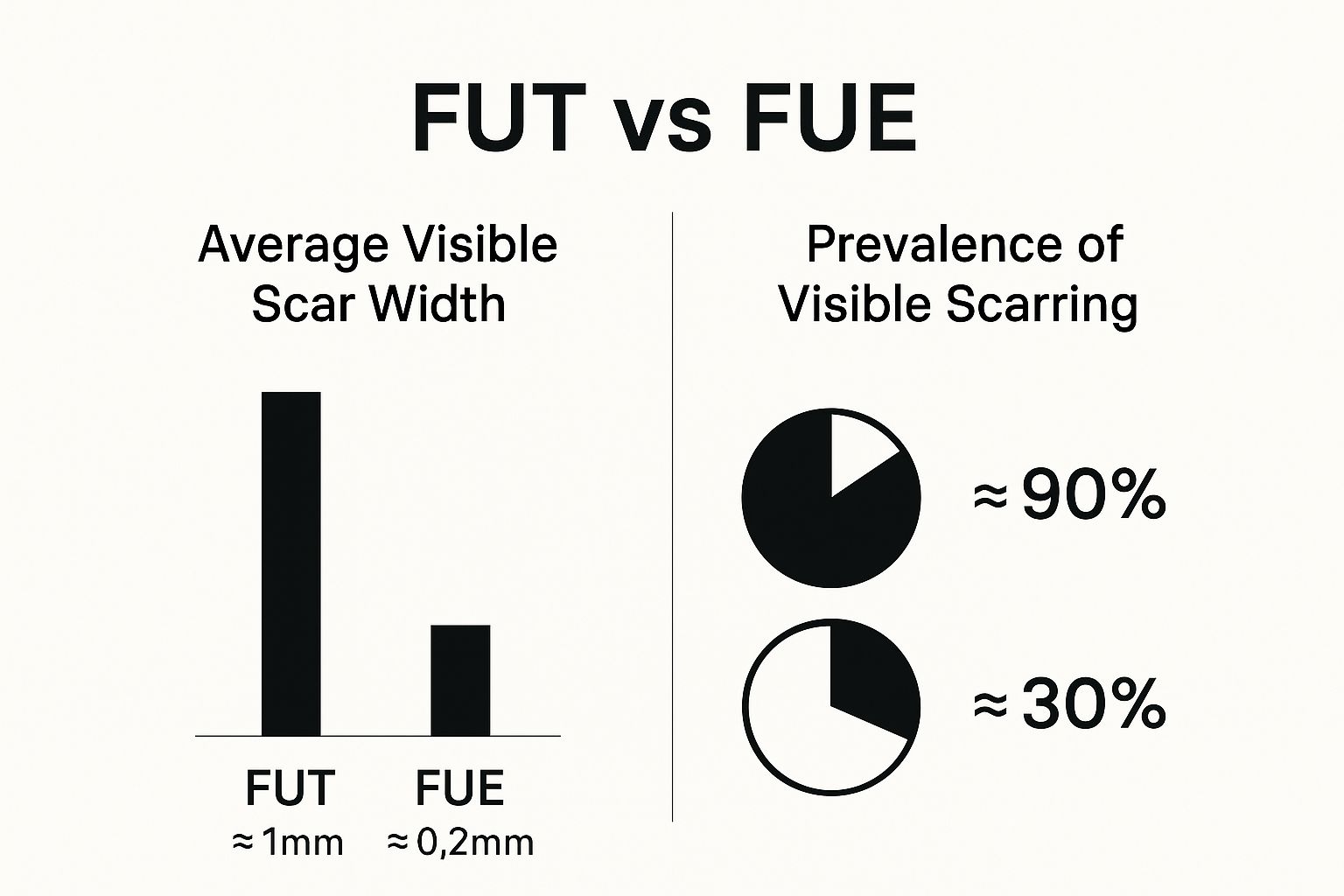
Scarring Comparison FUT vs FUE Procedures
To put it all into perspective, let's break down the key differences side-by-side.
| Feature | FUT (Strip Method) | FUE (Extraction Method) |
|---|---|---|
| Scar Type | A single, long linear scar | Multiple tiny, dot-like scars |
| Visibility | Easily concealed with longer hair (over 1 cm) but can be visible with very short or buzzed styles. | Extremely difficult to detect, even with very short hair. Blends with surrounding follicles. |
| Size | Varies, but typically 1-2 mm in width. The length depends on the number of grafts harvested. | Micro-sized, typically less than 1.0 mm in diameter per scar. |
| Concealment | Relies on surrounding hair growth for cover. Trichophytic closure helps significantly. | Dispersed nature makes them self-camouflaging. Difficult to spot without very close inspection. |
| Hairstyle Freedom | Limited. Very short haircuts may expose the scar. | Maximum freedom. Ideal for fades, buzz cuts, and other short styles. |
While both methods are effective, the trend in Australia has definitely shifted towards FUE, driven by patients wanting the most discreet result possible. If you want to dig deeper into this technique, you can learn more about what an FUE hair transplant involves right here.
Your Scar Healing and Recovery Timeline
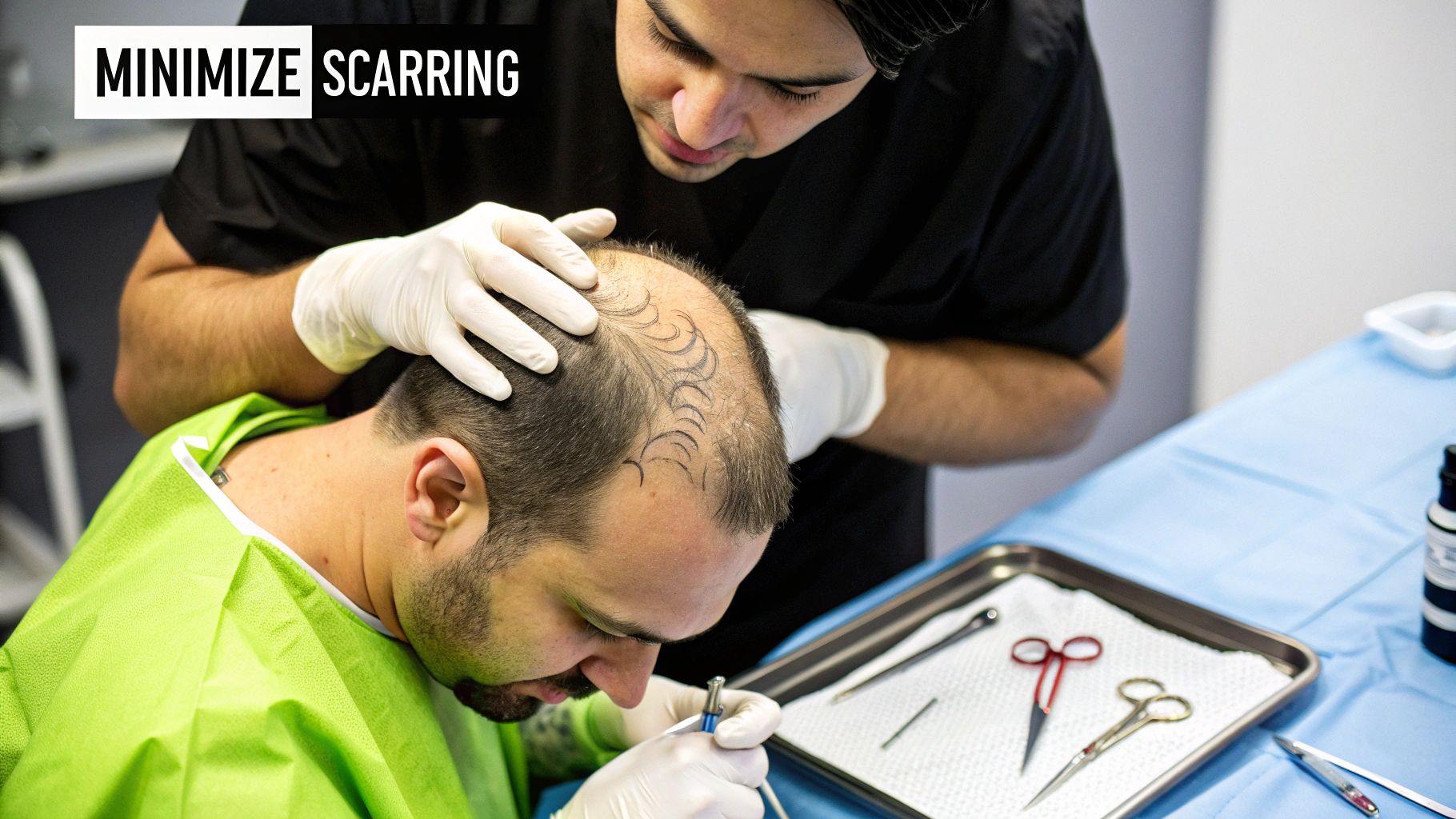
Knowing what to expect as your hair transplant scar heals is key to a stress-free recovery. This isn't an overnight fix; it's a gradual journey as your skin meticulously repairs itself. Think of this timeline as a clear roadmap for your donor area, whether you've had an FUT or FUE procedure.
The healing journey is a fascinating biological process. It kicks off with inflammation and clot formation, shifts into producing collagen, and finally settles into a long-term remodelling phase. Understanding these stages helps you recognise what's normal and appreciate the incredible work your body is doing behind the scenes.
The First Two Weeks: Immediate Healing
This initial phase is all about acute recovery. In the first few days, you'll definitely see some redness and mild swelling, along with tiny scabs forming over the extraction sites or along the incision line. Don't worry—this is actually a great sign that your body's healing response is in full swing.
By the time the first week is over, most of that initial discomfort should be a memory. The small scabs in the donor area will start to flake off on their own. The golden rule here is simple: don't pick at them. Messing with the scabs can disrupt the delicate healing process and might even make your final hair transplant scar more noticeable.
During this period, your number one job is to follow your clinic's aftercare instructions to the letter. Gentle washing, avoiding any heavy lifting or strenuous workouts, and keeping your scalp protected are non-negotiable for creating a clean, healthy healing environment.
By day 10 to 14, the donor area should look much clearer. The scabs will be mostly gone, and that initial bright redness will have started to fade into a softer pinkish colour. The skin is closing up, laying the foundation for the long-term scar maturation to come.
One to Three Months: Settling and Fading
Once the surface has healed, the scar gets down to the business of maturing. Over this period, the pinkness will continue to fade, and you'll feel the scar tissue start to soften and flatten out. The whole donor area will look much calmer and more settled.
Underneath the surface, your body is busy reorganising the collagen fibres, which strengthens the repaired tissue. It’s a slow and steady process, so patience is key. For FUE patients, this is when the tiny dot-like scars become harder and harder to spot as they blend into your natural skin tone. For FUT patients, the linear scar will become paler and less raised.
- Protect from the Sun: UV exposure is the enemy of a healing scar. It can cause hyperpigmentation, making the scar darker and more obvious. A hat is your best friend when you head outdoors.
- Maintain Scalp Health: Keep your scalp healthy and hydrated. A well-cared-for scalp provides a better environment for healing.
- Monitor Your Progress: While you’ll see big changes during these months, remember that the final result is still a way off.
Three Months to One Year: Full Maturation
The last stage of scar healing can take up to a year, and sometimes even a little longer. Throughout this time, the scar tissue keeps remodelling itself, becoming softer, flatter, and closer to your natural skin colour. That network of collagen becomes more organised and stable, leading to the scar's final, settled appearance.
By the one-year mark, your hair transplant scar should be pretty much as good as it's going to get—well-healed, pale, and often very difficult to detect. Proper aftercare plays a huge role in getting to this point, and it’s also worth understanding how treatments like scalp micropigmentation can help. To learn more, check out our guide on the scalp micropigmentation aftercare procedure to see how post-treatment care makes all the difference.
How to Minimise and Prevent Visible Scars
While you can't have a hair transplant without some scarring, the final result is definitely not set in stone. The steps you take before and after your procedure have a massive impact on how well everything heals, potentially making any scar virtually invisible. You have more control over the outcome than you might think.
The single most important decision you'll make is choosing your surgeon. An experienced, highly skilled specialist knows exactly how to work with the scalp's anatomy to create the smallest, cleanest incisions possible. That precision is the foundation for minimal scarring.
Your Role in Achieving the Best Outcome
Think of this as a team effort. Your surgeon does their part in the clinic, and you do yours at home. Following your pre- and post-operative instructions isn't just a suggestion—it's essential for avoiding complications that can make scars much more obvious.
Here are a few key things to focus on:
- Avoid Strenuous Activity: Getting your heart rate up with heavy exercise pumps more blood to your scalp. This can put tension on the donor area incision, potentially stretching the scar and making it wider. Stick to the timeline your surgeon gives you for getting back to the gym.
- Protect Your Scalp from the Sun: UV radiation is a real enemy of healing skin. Sun exposure can cause hyperpigmentation, which permanently darkens the scar tissue. A dark scar on a lighter scalp is much easier to spot.
- Follow Aftercare Protocols: Keeping the area clean and cared for is your best defence against infection. An infection can completely derail the healing process and will almost certainly worsen the final look of any hair transplant scar.
Your commitment to aftercare directly impacts the final visibility of your scar. Think of it as a partnership between you and your surgeon—their skill in the clinic is matched by your diligence at home.
Advanced Support for Superior Healing
Beyond the basics, modern aesthetic treatments can give your body’s natural healing process a serious boost. These adjunctive therapies are becoming a go-to for patients who want the absolute best result.
For instance, Platelet-Rich Plasma (PRP) treatments are a fantastic option. This therapy uses powerful growth factors isolated from your own blood to speed up tissue repair, calm inflammation, and encourage healthy collagen to form in the donor area. The result is often a softer, flatter, and less noticeable scar.
The growing demand for these kinds of complementary treatments is part of a bigger picture in the Australian hair transplant market, which is projected to grow at a staggering 22.19% annually from 2025. This surge is largely driven by patients opting for minimally invasive FUE procedures and wanting a more holistic approach that supports healing from every angle.
And if you do have any lingering visible scarring, there are brilliant non-surgical ways to hide it. Our guide on what is scalp micropigmentation explains how this specialised cosmetic tattoo technique can expertly camouflage scars, making them blend seamlessly with the surrounding hair.
Treatments for Existing Hair Transplant Scars
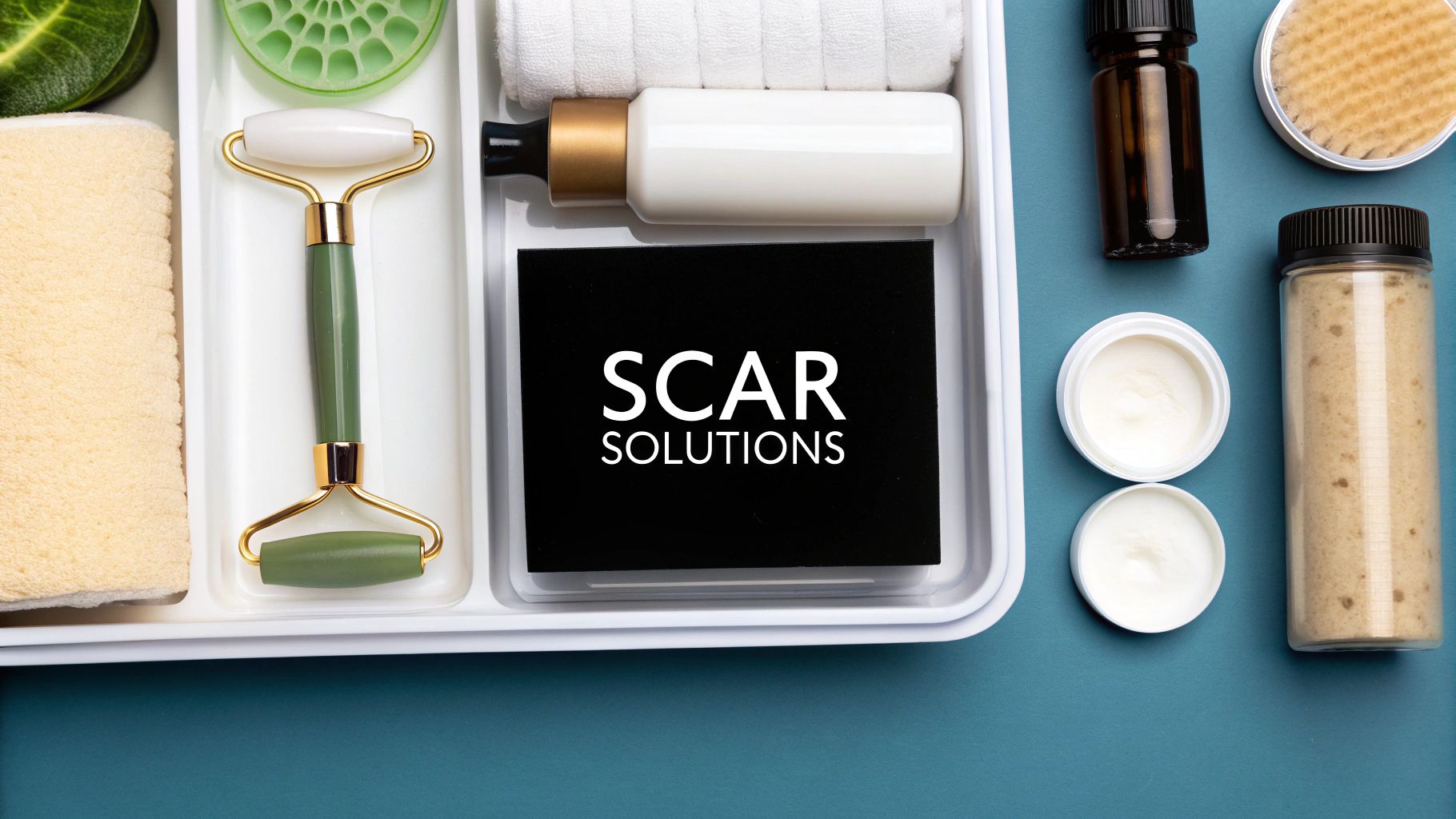
If you're self-conscious about an old hair transplant scar, take heart. The options available today for dealing with them are more effective than ever, meaning you don't have to live with a constant reminder of a past procedure.
Modern techniques can dramatically soften the appearance of scarring, giving you back the confidence to wear your hair how you want.
Whether it’s a linear scar from an older FUT procedure or the tiny dot scars from FUE, there are a few different avenues you can take. These solutions range from clever cosmetic camouflage to advanced medical treatments that actually repair the scar tissue itself.
Scalp Micropigmentation for Scar Concealment
One of the most popular and effective solutions right now is Scalp Micropigmentation (SMP). It’s best to think of it as a highly specialised form of cosmetic tattooing, but one designed purely for the scalp.
A trained technician uses micro-needles to deposit tiny dots of pigment into the skin, meticulously matching them to your natural hair colour and follicle size.
When applied over a hair transplant scar, these dots mimic the look of individual hair follicles. This clever technique breaks up the solid line or pale surface of the scar, drastically reducing the contrast between the scar tissue and the surrounding hair. The end result is that both FUT and FUE scars blend away into the scalp.
SMP doesn't actually remove the scar; it just camouflages it with incredible skill. It creates the illusion of a full, even head of hair, making scars practically invisible even if you like to keep your hair short.
This non-surgical approach delivers immediate results with no downtime, which is why it has become such a go-to for scar concealment. To get a better sense of how it works, you can check out our detailed guide on https://www.mytransformation.com.au/blogs/news/scalp-micropigmentation-for-hair-transplant.
Medical and Surgical Scar Revision Options
For those who want to improve the scar tissue itself, there are several medical treatments worth looking into. These methods focus on physically changing the scar's texture, colour, and structure to make it less obvious.
Common Scar Revision Techniques:
- Laser Treatments: Advanced fractional lasers can be used to resurface the scar tissue. This process kicks off collagen production, which helps to flatten raised scars, improve their texture, and dial down any redness. The goal is to make them blend in much better with the surrounding skin.
- FUE into the Scar: This is a clever approach for some FUT scars. It involves transplanting new, individual hair follicles directly into the scar tissue. This not only provides natural hair coverage from within the scar but also helps to break up that solid, linear appearance.
- Surgical Revision: If an FUT scar has healed poorly and stretched out, a surgeon might recommend a revision. This involves surgically removing the old scar tissue and carefully closing the incision again using more advanced techniques to create a much finer, less noticeable line.
Recent Australian data shows that while a small percentage of patients (around 1.9% to 2.6%) specifically seek procedures for scar repair, the issue is a major concern for men aged 30-49 and women aged 40-59. For people in these groups, a visible scar can really limit hairstyle choices and knock their confidence, making these revision options incredibly valuable.
For anyone curious about complementary therapies that can support the healing of scar tissue, you might find it interesting to learn how hyperbaric oxygen therapy can aid healing and recovery. Ultimately, by pairing the right technique with a skilled practitioner, you can get a result that makes a past scar a distant memory.
Frequently Asked Questions About Hair Transplant Scars
Diving into the world of hair restoration can bring up a lot of questions, especially when it comes to long-term results like scarring. Let’s tackle some of the most common queries with clear, straight-up answers to give you the confidence you need.
Is FUE Really a Scarless Procedure?
This is probably one of the biggest myths out there. The truth is, no surgical procedure is ever completely scarless, and Follicular Unit Extraction (FUE) is no different. But what FUE is designed to do is leave the most minimal, discreet scarring possible.
Instead of a single, long scar, an FUE procedure leaves behind hundreds of tiny, dot-like scars where each follicle was removed. These are usually less than 1.0 mm wide and are scattered across the donor area on your scalp. Once they’ve healed, they're incredibly difficult to see with the naked eye, even if you wear your hair quite short, because they just blend in with everything else.
How Long Does Redness in the Donor Area Last?
Seeing some redness after your procedure is a totally normal part of the healing process, so don’t be alarmed. For most people, this inflammation is at its most obvious during the first week.
By the time you hit the end of week two, that redness should have faded quite a bit, shifting to more of a light pinkish tone. Over the next one to three months, it will continue to fade back to your natural skin colour. Stick to your aftercare instructions, especially keeping the area out of the sun, as this really helps the redness settle down as fast as possible.
Can I Still Wear a Short Haircut After My Transplant?
Absolutely! But the type of procedure you choose really makes a difference here. This is where FUE has a huge advantage. Because the scars are just tiny, scattered dots, they are virtually impossible to spot with shorter styles like fades or buzz cuts. This gives you total freedom to style your hair how you want.
On the other hand, a Follicular Unit Transplantation (FUT) procedure leaves a single, linear scar. To keep it hidden, you’ll need to wear your hair a bit longer—usually over 1 cm—to get enough coverage. A really short buzz cut would almost certainly reveal an FUT hair transplant scar.
The key takeaway is this: FUE is the preferred method for anyone who wants the flexibility to wear their hair very short without worrying about visible scarring.
Will Hair Grow Through the Scar Tissue?
Generally speaking, hair won't just start growing through scar tissue on its own. A scar is formed from fibrous collagen, which doesn't have any hair follicles in it.
But, there are a couple of important exceptions to this rule. First, a highly skilled surgeon performing an FUT procedure can use an advanced technique called a trichophytic closure. This clever method encourages hair to grow directly through the scar line, camouflaging it brilliantly. Second, a common revision technique is to transplant new FUE grafts directly into an old scar to break up the tissue and create natural-looking coverage.
When you're planning your procedure, it’s smart to get a handle on all the different factors at play. The final result isn't just about the surgery; clinic reputation and the technology they use are also big parts of the puzzle. You can get a much clearer picture by reading our detailed guide on the overall hair transplant cost and what that number actually includes.
At My Transformation, we specialise in Scalp Micropigmentation (SMP), the ultimate non-surgical solution for camouflaging any type of hair transplant scar. Visit us today to discover how we can give you a flawless finish and complete confidence in your look.
